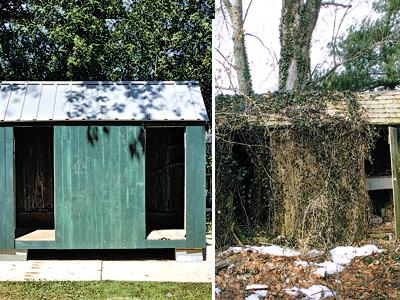Moran Bathhouse Reborn

The restoration of the only extant 19th-century bathhouse in East Hampton Village, one of several outbuildings on the Thomas Moran property on Main Street overlooking Town Pond and the first to be restored, has been completed.
Of all the structures on the property, the pine bathhouse was in the worst shape, according to Robert Hefner, the village’s director of historic services, who has been working on the restoration project for the Thomas Moran Trust since it took over the property from Guild Hall in 2008. Having completed a report on the artist’s studio and main house, which was designated a national historic landmark in 1965, he turned his attention to the outbuildings, and found that the bathhouse needed immediate attention if it were not to rot away or collapse under a heavy snowfall.
Early on, it was not even clear what the structure, 4 feet 8 inches by 10 feet 8 inches, had been used for. For one thing, it was blanketed by vines. For another, it had been used as a potting shed and its vertical boards were rotted. Its function as a bathhouse, transported to Main Beach in early summer and back to the Moran house for storage in early fall, likely by horse and wagon, did not make itself apparent until later on.
There were a few helpful clues. Ruth Moran, one of Thomas and Mary Nimmo Moran’s three children, once wrote to a friend that her family had a little green bathhouse that they’d take to the beach, a comment that Thurman Wilkins repeated in his 1998 biography of Moran: He “had a green bath house built and carted down to the beach every June . . . and back again in October.” In addition, two well-known paintings, “Beach at East Hampton,” c. 1875-1880, by John Ferguson Weir, and “East Hampton Beach, 1881” by Edward Lamson Henry show bathhouses that look very much like the one found on the Moran property. Stafford Tillinghast, who built the main house, may have built the bathhouse as well, but that is not known.
The goal was to preserve the interior with the frame and build new boards outside. The rotted boards were replaced with old timber given to Mr. Hefner as a gift. The roof had not survived, and the new one, built with “the utmost structural simplicity,” said Mr. Hefner, is of board-and-batten, which, he said, “is rare — you never see a board-and-batten roof out here.” Some of the bathhouses in the Weir painting do have that kind of roof, however.
The new boards on the outside were custom-made to duplicate the original ones. The inside, divided into two compartments by a five-foot-high board partition, had a bench along the back walls. Mr. Hefner recommends in his report conserving the pine wallboards and painting them their original gray color.
The clincher could just be the 28 wooden pegs around the perimeter, which would have been used to hang the clothes the family had worn to the beach before changing into their bathing costumes.
John Hummel Custom Builders moved the tumbledown structure to the barn at the Mulford Farm on James Lane, where Adam Galecki, who runs the Hummel woodworking shop, did the restoration. “He’s very meticulous,” Mr. Hefner said recently. The Hummel company was also called upon for the recent reshingling job on the Hook Mill.
In the same year that the Moran Trust took over responsibility for the property, East Hampton Village purchased a preservation easement on it, which not only brought in $500,000 of community preservation fund money but also allowed the village to participate in the restoration process. The trust has raised about $4 million to date, and is planning to raise another $4 million, which will provide for an endowment.
As soon as the trust obtains a special-use permit from the village it will proceed with the restoration of the main house and the other outbuildings. The bathhouse, not being considered a permanent structure, did not need a permit.
Its restoration will be celebrated tomorrow at the clubhouse of the Bridge golf club on Millstone Road in Bridgehampton. Tickets for the event, which will benefit the Thomas Moran Trust, start at $150.
